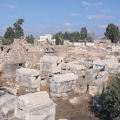AL BASS ARCHAEOLOGICAL SITE
The site is accessed by road along the Palestinian camp of Al Bass east of Tyre. It is 500 m south of the roundabout Al Bass. This site is very broad. In summer, under a sun of lead, the visit can be busy, so come early in the morning.
Once inside the site, you must take the Byzantine path made of rafters limestone slabs. On both sides, there is a vast Romano-Byzantine necropolis that includes a large number of sarcophagi and buildings and funeral pens. The whole was built between the second and the Ve s. of our era.
A first sarcophagus was exhumed in 1940 by French soldiers stationed in Tyre, but it was necessary to wait a few years before the whole necropolis was discovered. It is rich in hundreds of marble or stone sarcophagi. With bas-reliefs, they are now exposed to the National museum in Beirut. This is the case of magnificent tombs tracing episodes of the life of Achille, according to Homer's Iliad. Engraved on marble, the name and profession of the deceased indicate that many sarcophagi inhabited the body of large purple manufacturers.
On your left, the funeral chapel dates back to the th century. It consists of a small courtyard with a fountain, a semicircular room (its soil is paved with marble). Unlike the Byzantine path, the tomb-tower dating from the th century is distinguished. C.C.
At the end of the Byzantine road - shortly before it gives way to the Roman way - rises a monumental arc, high 20 m, built of sandy stone by the Romans in the second century. He collapsed in the Fifth or the th century during one of the earthquakes. There is a very clear distinction between wheel traces in the limestone Paving of the Roman track. To the south of this route, the pedestrian pavement retained its pavement in chevron. It was lined with a row of shops sheltered by the aqueduct that brought fresh water from Ras el-Ain to the city (6 km from Tyre).
The kings fountain is preceded by a small mosaic courtyard. This funeral complex is decorated with several niches and various basins. The deceased was buried behind the fountain. To the south of this fountain, the blues of the Blues include a mosaic where the blues'victory is inscribed.
480 m long and 160 m wide, the Tyre racetrack, built in the th century as a hair pin, is one of the largest and best preserved in the Roman world. Its stone stands on the ground allowed for up to 20 000 seated spectators. Spina, like long wall, marked the centre of the track. In his midst, a granite obelisk was found (now raised) and a little further the statue of Hercules. Later, a Byzantine chapel was built on the abandoned site. In Roman times, races attracted passionate crowds. Pending the departure, ten tanks took place at the end of the spina for which they had to do seven times the tour. During the fall of the Roman Empire, the racecourse was abandoned and buried over the centuries under six metres of sand.







